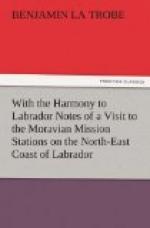This part of the coast is rugged and grand. There is a good deal of snow on the heights of Aulatsivik and the northern extremity of that great island is a bold precipitous cliff. Port Mauvers, at the mouth of the narrow strait, which separates Aulatsivik from the mainland, figures so prominently as a name upon most maps of Labrador, that one might suppose it to be at least the capital. But there are no inhabitants there, nor indeed all along the coast between Nain and Okak. Kiglapeit, to the north, is so splendid a mountain range that I am quite sorry we shall pass it in the dark. We are getting more into the open sea as evening advances, and there are icebergs to be seen here and there.
Come into the captain’s cabin and look at this little budget of letters. They are notes from Eskimoes at our southern stations to their relatives and friends in the north. Some are funny little pencilled scraps folded and oddly directed, e.g. “Kitturamut-Lucasib, Okak.” That means “To Keturah (the wife) of Lucas or Luke, at Okak.” Our Eskimoes seem to have a talent for phonetic spelling; “ilianuramut” is evidently “To Eleanor,” and “Amaliamut-kuniliusip, Okak,” is meant for “Amalia (the wife) of Cornelius at Okak.” Some are very respectable epistles, and I doubt not the Christian tone of most would please us could we read the Eskimo language, with its strange long words. Here is a good-sized letter folded and directed in a bold clear hand, “Sosanemut-Andoneb, Hibron” (To Susannah, the wife of Antony at Hebron). It is not sealed, so, as we shall scarcely understand a word of its contents, we will venture to open it and glance at them. It is a well-written letter, covering three pages of blue foolscap paper, so it must be conveying a good deal of news to Antony and Susannah. The writer names himself at the commencement, “Boas-Kedoralo.” “Lo” is Eskimo for “and,” and “Kedora” is another phonetic version of Keturah. He closes his long epistle with “Amen.”




